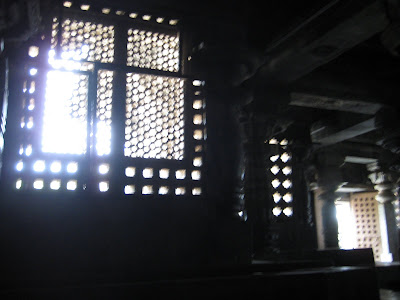
When I first arrived in Bangalore I joined the Bangalore Expat Club. They do happy hours, dinners, and most importantly, day trips. Last month I went on a trip they organized to two 800 year-old temples about 4 hours from Bangalore.
The first was called Hoysaleswara, in the city of Halebidu, which means "ruined city". That was not its first name. The original name was much longer, grander, and more befitting what was in the 12th century the capital of the Hoysala Empire. It wasn't until the 14th century, when the temple was almost finished, that it was sacked by an army lead by a Eunuch-slave general, Malik Kafur, and fell into its everlasting ruinous state.
And by "ruinous", I mean "breathtaking." For the most part, the pictures speak for themselves.



This is our guide, showing the wall in different stages of completion. Because construction wasn't ever finished, you can see on this wall how the carving was done in stages:

A statue of a temple dancer:

The platform for the live temple dancers:

Elephants would have been used to turn these pillars in place of a mechanized lathe:

Inside of the temple looking out:

Now comes the part where many traditional Hindu stories are beautifully represented in stone. Our guide described the significance, of each, but alas, I didn't take notes so I can only offer very vague descriptions.
This is Ganesh:

This is a god lifting up a mountain. It has the most detail of any of the carvings.

This carving shows a god trapped inside of an elephant's stomach. You can see he is trying to escape by piercing the animal from the inside with his thumbnail. The elephant is oriented with his head smashed into the ground, and his feet pointing to the (viewer's) right. The god is reaching up right where the light hits the upper right corner.

I swear, and the other Expats will back me up, that this carving depicts a wife riding behind her husband on an elephant, looking terrified and almost falling off of the back. Her right hand is raised in protest of his driving skills. This is certainly the oldest back-seat-driving representation I've ever seen!


WARNING!!! The next photo is marginally NSFW!!!
You just don't find stuff like this on European cathedrals.

This temple is a shrine to Lord Shiva, so natrually, Nandi statues abound. Here's the "king" Nandi statue:


And here's the queen:



We saw this tree on the way out. It was gorgeous.

Thanks for the wonderful vicarious trip. Great pictures and commentary! Love, Mom
ReplyDelete'Love' the pics ha ha..thanks for sharing!
ReplyDeletegood ones!
ReplyDelete